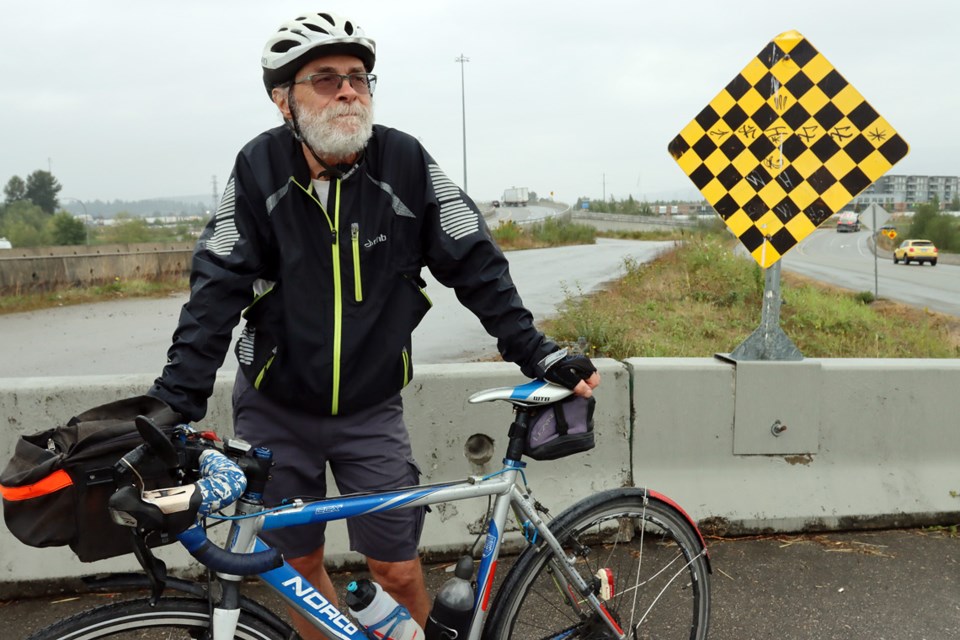Cyclists crossing the Pitt River Bridge are frustrated by the lack of infrastructure improvements first proposed 14 years ago as part of the span’s design consultation process.
As a result, they’re left navigating a confusing array of paths and dangerous traverses of local streets, as well as two tight hairpin turns on the Port Coquitlam side that present a challenge to novice cyclists, longer tandem bikes or bikes towing trailers, says Dave Rush, who crosses the bridge regularly from Pitt Meadows.
Rush said with more people travelling on two wheels — including e-bikes — and a growing emphasis on active transportation across the region, hap-hazard access solutions for cyclists are no longer good enough.
“Every time I go over that bridge, I get frustrated,” he said. “You’re mixed up with the cars quite often and if you’re inexperienced, that can be very intimidating.”
Rush, who was involved in the design consultation process before the bridge was opened in 2009, said the end result was “disappointing from what we expected.”
A 2007 report presented to B.C.’s Ministry of Transportation by Vancouver-based design consultants Kirk & Co. made several recommendations for the planned bridge, including:
- An extended ramp on the westbound side of the bridge so cyclists have more space to slow down while descending from the deck
- A direct link from the bridge to the north side of Lougheed Highway
- Fewer at-grade street crossings
- Cyclist access on the south side of the bridge so they can get on it directly from the Mary Hill Bypass and Lougheed Highway
The report also noted the cycling community was pleased it was included in the design consultation process.
However, 12 years after the bridge officially opened, none of the recommendations have been realized.
Rush said he’s particularly dismayed a separate bus lane connecting directly to westbound Lougheed Highway via an underpass beneath the ramp from the Fremont Connector to the Mary Hill Bypass has been closed off by concrete barriers for years. The route would make it easier for bike commuters rather than navigating a series of turns and intersections along Belfast Street and Fremont that eventually link to the north side of Lougheed.
Meanwhile, westbound cyclists trying to access the Mary Hill Bypass area have to cross Belfast Street, loop back around under the bridge along a multi-use path (MUP), then navigate a narrow sidewalk beneath the CP Rail overpass against the general flow of bike and pedestrian traffic.
Eastbound cyclists have it even worse, as they’re forced to find their way through an array of turns and routes to be able to cross the bridge on its north side, against the flow of westbound users.
Andrew Hartline, of Tri-Cities HUB, a cycling advocacy group, said the Pitt River Bridge problem is one of several major gaps in safe infrastructure cyclists face getting through the Tri-Cities, including inadequate connections to the Port Mann Bridge from the Central Valley Greenway and Colony Farm.
“No one took the responsibility to plan it out very well,” he said, adding opening the bus lane to cyclists, as well as the flyover from Fremont to the Mary Hill Bypass, would improve things immensely.
But a spokesperson from the Ministry of Transportation and Infrastructure said directing cyclists to the existing multi-use path is still the safest option.
“The ministry appreciates the concerns people have raised about cycling connections in this area,” said the spokesperson in an email to the Tri-City News, adding staff are meeting with cycling advocacy groups and regional agencies to get a better understanding of gaps in the cycling network around Metro Vancouver and the Fraser Valley.
Rush said he’s dismayed by the slow pace of improving the situation for cyclists, explaining he’d rather take his chances by riding on the busy roadway, timing his crossings to take advantage of lulls in the traffic created by lights at either end.
“I don’t want to have to do that,” he said.
Have your say
HUB Tri-Cities is collecting feedback about cycling in the Tri-Cities as part of the advocacy group’s annual GoByBike campaign that begins Sept. 27. To submit your thoughts, you can use the TriCityFix app on iPhone or Android devices, or email [email protected].




